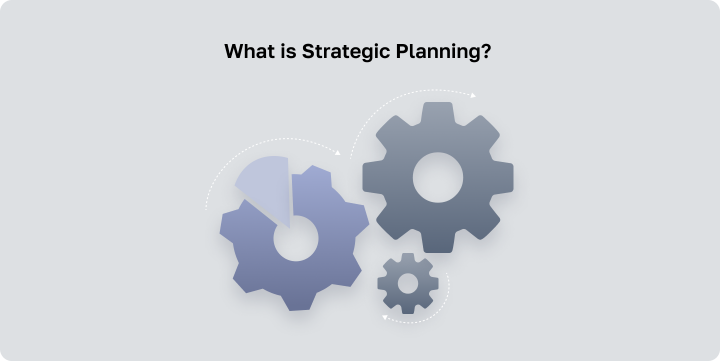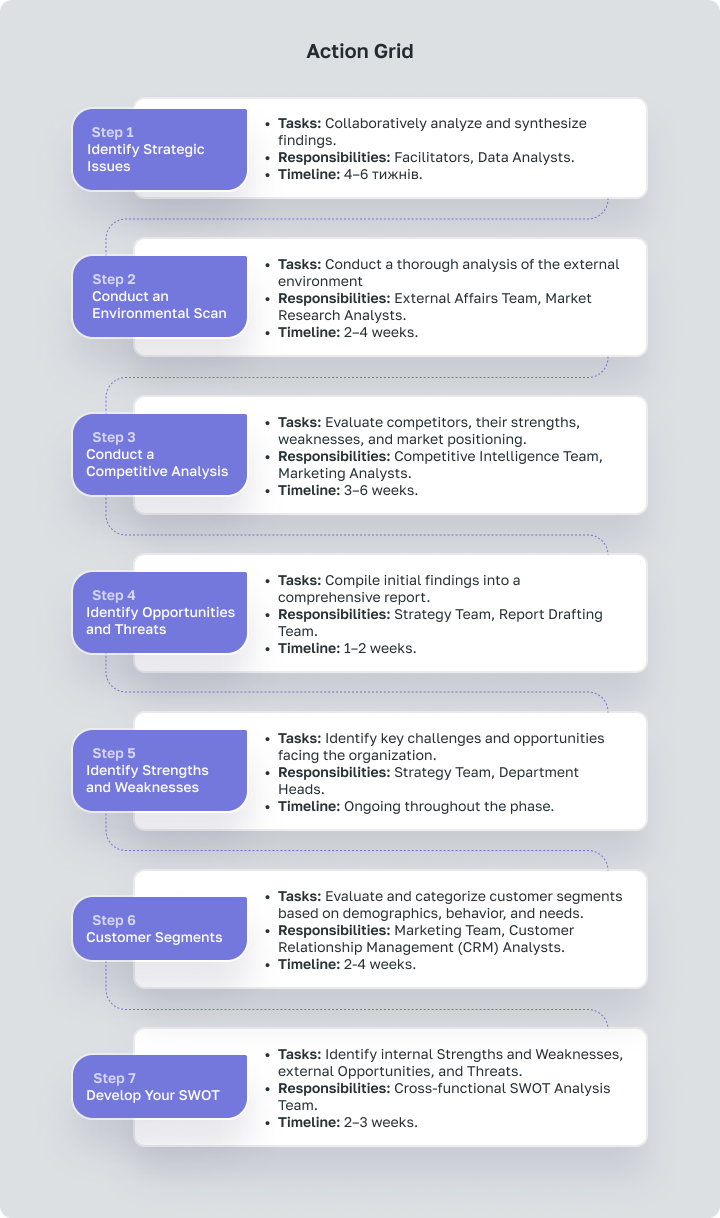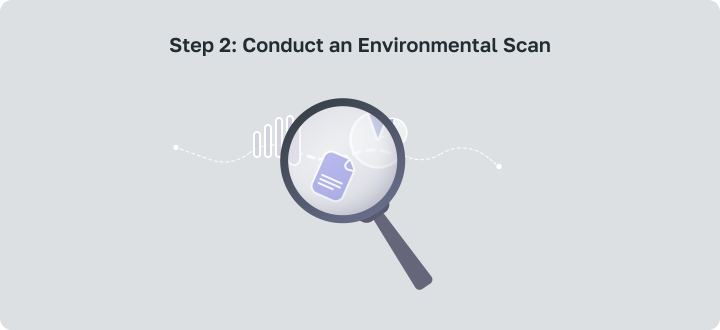A well-defined strategic plan is essential and acts as a roadmap, steering organizations through challenges, fostering adaptability, and capitalizing on opportunities. Creating a strategy ensures proactive decision-making, fostering resilience and sustainable growth. Delving into the four phases of strategic planning reveals a structured approach that seamlessly interweaves execution, advanced strategy, and implementation to lead organizations to success.
What is Strategic Planning?
The strategy process involves setting clear goals, identifying potential challenges, and devising a comprehensive roadmap to achieve long-term success. Its proactive approach enables businesses to navigate uncertainties, capitalize on opportunities, and adapt to a rapidly changing environment.

Strategic planning encompasses a series of deliberate steps, involving analysis, decision-making, and execution, aligning all facets of an organization toward a common vision.
What is the Strategic Planning Process?
Strategic planning involves a series of interconnected phases, each serving a distinct purpose in guiding the organization toward success. It defines the direction and purpose of the organization and enables adaptability in response to internal and external changes. The strategic planning process serves as a dynamic tool for organizations to manage complexity, optimize resources, and foster sustainable growth through careful analysis, decision-making, and execution.
Strategic Planning Process Overview
The strategic planning process consist of four key phases of strategic planning — environmental scanning, strategy formulation, strategy implementation, and evaluation and control — it involves rigorous analysis, decision-making, and action.

From assessing internal and external factors to executing and monitoring strategies, each stage of the strategic planning process plays a crucial role in aligning the organization with its goals.
Introduction
The strategic planning process is a holistic approach that empowers organizations to navigate the complexities of their future. Such an introduction sets the stage for a comprehensive exploration of each component to develop a strategic plan.
Getting Started: Strategic Planning Introduction
The strategic planning process commences with the kick-off phase, typically spanning a few weeks. Key questions during this phase of strategic planning revolve around clarifying organizational goals, understanding stakeholder expectations, and assessing current challenges.
Step  : Determine Organizational Readiness
: Determine Organizational Readiness
Before diving into strategic planning, it’s crucial to assess the organization’s readiness for this transformative journey. Key questions illuminate the path forward strategic planning:
- Is there a shared understanding of the organization’s purpose and objectives?
- Are leaders committed to fostering a culture of strategic thinking?
- Is the necessary data and information readily available for strategic planning analysis?
Step  : Develop Your Team & Schedule
: Develop Your Team & Schedule
Assembling a dedicated project team is pivotal for the success of the strategic planning process. Identify individuals with diverse skills, representing various departments and levels of the organization. Ensure a balance of creativity, analytical prowess, and a commitment to the organization’s mission. Appoint a capable team leader to guide the strategic planning process and foster collaboration.
Simultaneously, establish a well-defined strategic planning schedule. Break down tasks into manageable timelines, considering the complexity of the organization and the depth of analysis required for strategic planning. Incorporate flexibility to accommodate unforeseen challenges. Regular team meetings, stakeholder consultations, and progress reviews should be integral parts of the strategic planning schedule. This careful team selection and meticulous scheduling set the stage for a cohesive and effective strategic planning process.
Step  : Collect Current Data
: Collect Current Data
Gathering relevant and current data is the bedrock of informed decision-making in the strategic planning process. This step involves a comprehensive analysis of the internal and external factors that influence the organization. Internally, assess financial performance, employee capabilities, and operational efficiency. Externally, scrutinize market trends, competitive landscapes, and emerging opportunities or threats.
Accurate and up-to-date data empowers the planning team to identify strengths, weaknesses, opportunities, and threats (SWOT analysis) critical for strategy formulation. It ensures a realistic assessment of the organization’s current standing and potential areas for improvement. By leveraging this foundation of data, organizations can craft strategic planning initiatives that align with their objectives and respond effectively to the dynamic forces shaping their environment.
Step  : Review Collected Data
: Review Collected Data
The analysis of collected data marks a pivotal phase in the strategic planning process, serving as the bridge between information gathering and strategic decision-making. This step of strategic planning involves a meticulous review, interpretation, and synthesis of the gathered data. By identifying patterns, trends, and correlations, organizations gain a nuanced understanding of their current state and the dynamics of their operating environment.
A robust data review enables the strategic planning team to uncover insights that inform the subsequent phases of the strategic planning process. It highlights key opportunities, potential challenges, and areas requiring strategic planning focus. This analytical foundation ensures that the ensuing strategies are not only well-informed but also tailored to address the unique needs and aspirations of the organization, enhancing the likelihood of successful strategic planning implementation and achievement of long-term objectives.
Phase 1: Determine Your Strategic Position
In the inaugural phase of the strategic planning process, the focus is on understanding the organization’s strategic position. This involves a rigorous examination of internal and external factors, encompassing environmental scanning and competitive analysis. Identifying strategic problems and opportunities sets the stage for informed decision-making for strategic planning.

By assessing market dynamics, organizational capabilities, and competitive landscapes, this phase of strategic planning lays the groundwork for crafting strategies that leverage strengths, mitigate weaknesses, and position the organization advantageously in its operating environment. Strategic difficulty identification becomes the compass guiding subsequent steps in strategic planning.
Action Grid
The Action Grid ensures a systematic approach to understanding the organization’s strategic position, fostering collaboration among teams, and providing a comprehensive foundation for the subsequent phases of the strategic planning process.

Step 1: Identify Strategic Issues

Identifying strategic issues is the cornerstone of effective strategic planning, requiring a deliberate and comprehensive approach. Start by posing essential questions:
- Organizational Purpose: What is the core purpose of our organization, and how does it align with current market demands?
- Market Dynamics: What external factors impact our industry, and how can we navigate or leverage them?
- Internal Assessment: What are our key strengths and weaknesses in terms of resources, capabilities, and operations?
- Stakeholder Perspectives: How do key stakeholders perceive our organization, and what are their expectations?
- Competitive Landscape: What are the strengths and weaknesses of our competitors, and where do we stand in comparison?
Responsibilities include engaging cross-functional teams, involving leadership, strategy experts, and market analysts. This collaborative effort ensures diverse perspectives in identifying critical issues in strategic planning.
The timeline for this phase of strategic planning typically spans 4 – 6 weeks, allowing for thorough analysis and discussion to pinpoint strategic challenges and opportunities effectively.
Step 2: Conduct an Environmental Scan

Performing a comprehensive environmental scan is a critical step in strategic planning to understand and adapt to external conditions. Follow these steps:
- Define Scope and Objectives: Clearly outline the scope of the environmental scan and its objectives.
- Identify Key Factors: Determine the critical factors affecting your organization, including economic, technological, regulatory, and societal aspects.
- Gather Data: Collect relevant data through market research, industry reports, and trend analyses.
- PESTEL Analysis: Systematically analyze Political, Economic, Social, Technological, Environmental, and Legal factors impacting your organization.
- Competitive Landscape: Evaluate the competitive landscape, identifying key players, market share, and emerging trends.
- SWOT Analysis Validation: Validate and refine the SWOT analysis based on external factors identified.
- Scenario Planning: Develop scenarios to anticipate potential future developments and their implications.
- Stakeholder Consultation: Engage with stakeholders to gain diverse perspectives on external factors.
Responsibilities include assigning dedicated teams for data collection, analysis, and scenario development.
The timeline for this step of strategic planning typically spans 6 – 8 weeks, ensuring a thorough understanding of the external environment and providing a solid foundation for subsequent strategic decisions.
Step 3: Conduct a Competitive Analysis

A robust competitive analysis is integral to defining an organization’s strategic position. It involves a systematic evaluation of competitors to inform strategic decision-making. Follow these key elements:
- Identify Competitors: Clearly identify direct and indirect competitors within the industry.
- Gather Information: Collect data on competitors’ products, market share, pricing, and customer perception.
- Competitive Advantage Assessment: Analyze competitors’ strengths and weaknesses to identify areas where your organization can gain a competitive edge.
- Market Positioning: Determine how competitors position themselves in the market and identify opportunities to differentiate.
- SWOT Analysis: Conduct a SWOT analysis specifically focused on competitors to understand their strategies and vulnerabilities.
- Benchmarking: Benchmark your organization against industry leaders to set performance standards.
- Market Trends: Stay informed about emerging trends that may impact competition.
By systematically conducting a competitive analysis, organizations gain insights into market dynamics, potential collaboration opportunities, and strategic areas for differentiation. This knowledge is crucial for effective strategic planning that positions the organization strategically within the competitive landscape.
Step 4: Identify Opportunities and Threats

Identifying opportunities and threats is a pivotal step in strategic planning, requiring a focused approach. Address key issues through the following:
- Market Trends: Assess current and emerging market trends to identify growth opportunities.
- Technology Impact: Evaluate how technological advancements may create opportunities or pose threats to your organization.
- Regulatory Changes: Stay abreast of regulatory developments that may impact operations positively or negatively.
- Competitive Actions: Analyze competitors’ strategies and actions that may present opportunities or threats.
- Customer Behavior: Understand shifts in customer preferences and behaviors that may create opportunities or threats.
- Economic Factors: Evaluate economic conditions to identify potential opportunities or threats.
What do you want to capitalize on?
In strategic planning, the focus on capitalizing on opportunities is paramount. Organizations aim to leverage favorable circumstances, emerging trends, and untapped markets to propel growth and gain a competitive advantage. Capitalizing on opportunities involves aligning resources, capabilities, and strategies to maximize positive outcomes.
Whether it’s embracing technological advancements, responding to shifting customer preferences, or entering new markets, strategic planning process with examples shows that organizations not only adapt to change but also thrive in dynamic environments, fostering innovation and sustained success.
Questions to Ask:
Market Trends
- Question: What current market trends present opportunities for our organization?
- Answer: Analyzing trends in consumer behavior, technology, and industry developments helps identify avenues for strategic growth.
Technological Advancements
- Question: How can we leverage emerging technologies to create new opportunities?
- Answer: Exploring innovations in technology allows us to stay ahead and pioneer solutions for our market.
Customer Needs
- Question: What evolving customer needs can we address for new business opportunities?
- Answer: Understanding changing customer preferences guides product or service enhancements and market expansion.
Global Expansion
- Question: Are there untapped international markets for our products or services?
- Answer: Exploring global markets presents opportunities for diversification and increased revenue streams.
Collaboration Potential
- Question: How can strategic partnerships or collaborations open new doors?
- Answer: Partnering with industry leaders or complementary businesses can unlock synergies and mutual benefits.
Regulatory Landscape
- Question: How might changes in regulations create opportunities for our organization?
- Answer: Adapting to regulatory shifts proactively positions us to navigate and capitalize on changing landscapes.
By addressing these questions, organizations can identify and seize opportunities, fostering a proactive and innovative approach to strategic planning.
What do you need to mitigate?
Mitigating threats is crucial in strategic planning to safeguard an organization’s stability and resilience. Attention is directed towards identifying and addressing potential challenges that may hinder success. This involves proactive measures to minimize the impact of external factors such as economic downturns, regulatory changes, or competitive pressures.
This way, organizations enhance their ability to navigate uncertainties and fortify themselves against potential risks, ensuring a robust strategic position capable of withstanding challenges and sustaining long-term success in a dynamic business environment.
Questions to Answer:
Competitive Landscape
- Question: How can we adapt to emerging competitive pressures?
- Answer: Staying agile and continuously innovating helps maintain a competitive edge.
Economic Downturns
- Question: What strategies can we employ to withstand economic challenges?
- Answer: Diversifying revenue streams and implementing cost-saving measures enhance financial resilience.
Regulatory Compliance
- Question: How can we stay compliant with evolving regulations?
- Answer: Regularly monitoring regulatory changes and adjusting operations ensure ongoing compliance.
Technological Disruptions
- Question: What steps can we take to mitigate the impact of technological disruptions?
- Answer: Investing in technology upgrades and fostering digital literacy minimizes vulnerability.
Supply Chain Risks
- Question: How do we mitigate risks in our supply chain?
- Answer: Building alternative sourcing options and establishing robust supply chain management protocols enhance resilience.
Cybersecurity Threats
- Question: How can we safeguard against cybersecurity threats?
- Answer: Implementing robust cybersecurity measures and fostering a culture of security awareness enhance organizational protection.
Step 5: Identify Strengths and Weaknesses

Recognizing an organization’s strengths and weaknesses is pivotal for informed strategic planning. To uncover these aspects, ask pertinent questions:
- Internal Resources: What unique resources and capabilities set us apart in the market?
- Operational Efficiency: Where do we excel in our operational processes, and where do we face challenges?
- Employee Skill sets: What skills and expertise do our employees possess, and where are skill gaps?
- Financial Health: How robust is our financial position, and where are potential weaknesses?
- Innovation Capacity: How well do we foster innovation, and where can we improve?
What do you want to build on?
To build on strengths is to harness and amplify the distinctive attributes that set an organization apart. By emphasizing and leveraging existing capabilities, market advantages, and areas of excellence, organizations can establish a foundation for sustainable growth via strategic planning. Building the strategic plan on strengths involves strategic investments, talent development, and optimizing operational processes.
This proactive approach for strategic planning not only enhances competitive advantages but also fortifies the organization’s core competencies, positioning it for resilience and success in a business landscape.
Questions to Ask
Core Competencies
- Question: What are our key competencies that contribute to our success?
- Answer: Identifying and leveraging core competencies ensures a focus on strengths that differentiate us in the market.
Market Reputation
- Question: How is our brand perceived, and what aspects contribute to a positive reputation?
- Answer: Enhancing and promoting positive brand attributes strengthens our market position.
Customer Satisfaction
- Question: What aspects of our products/services lead to high customer satisfaction?
- Answer: Investing in and further developing these aspects cultivates customer loyalty and market presence.
Employee Expertise
- Question: In what areas do our employees excel, contributing to overall organizational success?
- Answer: Capitalizing on employee expertise builds a skilled and motivated workforce, enhancing organizational capabilities.
Innovation Culture
- Question: How do we foster innovation, and what unique ideas have contributed to our success?
- Answer: Nurturing and building on innovative practices sustains a culture of continuous improvement and adaptation.
What do you need to shore up?
Shoring up weaknesses involves addressing and fortifying vulnerable aspects of an organization to enhance overall resilience. By identifying and mitigating weaknesses, organizations can bolster operational efficiency, mitigate risks, and cultivate adaptability. This proactive stance involves strategic investments, skill development, and process optimization to shore up areas that may pose challenges.
This targeted approach to the strategic planning process ensures a more robust and well-rounded organizational structure, fostering long-term sustainability in the face of evolving market dynamics and potential adversities.
Questions to Answer:
Operational Processes
- Question: Where do our operational processes face inefficiencies or bottlenecks?
- Answer: Identifying and streamlining inefficient processes eliminates operational weaknesses.
Skill Gaps
- Question: What skills are lacking within our workforce, hindering optimal performance?
- Answer: Addressing skill gaps through training and recruitment strengthens organizational capabilities.
Financial Vulnerabilities
- Question: Where are potential financial weaknesses, and how can we mitigate them?
- Answer: Implementing cost-saving measures and financial planning minimizes vulnerabilities.
- Question: What technological gaps hinder our efficiency, and how can they be addressed?
- Answer: Investing in technology upgrades enhances operational capabilities and competitiveness.
Customer Feedback
- Question: Where do customer complaints or feedback highlight weaknesses in our products or services?
- Answer: Addressing customer concerns and improving offerings mitigates weaknesses in market perception.
By answering these questions, organizations can strategically address weaknesses and improve overall resiliency to foster a more robust operational base.
Step 6: Customer Segments

Understanding consumer segments is key in strategic planning to tailor offerings and experiences. This step of strategic planning involves a detailed exploration of diverse customer groups to address their unique needs and preferences. Relevant issues include:
- Segment Identification: Defining distinct customer segments based on demographics, behavior, or preferences.
- Needs Analysis: Understanding the specific needs and expectations of each customer segment.
- Market Positioning: Crafting strategies to position products or services effectively within each identified customer segment.
Who are we providing value to?
Identifying the target audience is essential for delivering value in strategic planning. Organizations must pinpoint who they are serving, and understand their unique needs and preferences. By defining the specific demographics, behaviors, and characteristics of the target audience, businesses can tailor their products, services, and messaging to resonate effectively.
This approach in the strategic plan ensures that value delivery aligns with the expectations and desires of the intended recipients, fostering customer satisfaction and loyalty while maximizing the impact of organizational efforts in the market.
Questions to Ask:
Demographic Information
- Question: What are the key demographic characteristics of our customer segments?
- Answer: Understanding demographics helps tailor products and marketing messages to specific audience groups.
Behavioral Patterns
- Question: How do customers interact with our products or services?
- Answer: Analyzing behavioral patterns informs strategies for product positioning and customer engagement.
Needs and Preferences
- Question: What are the distinct needs and preferences of each customer segment?
- Answer: Customizing offerings based on identified needs enhances value delivery.
Competitor Comparison
- Question: How do our customer segments compare to those targeted by competitors?
- Answer: Identifying competitive landscapes ensures differentiation and targeted marketing.
Market Trends Impact
- Question: How might evolving market trends affect the preferences of our customer segments?
- Answer: Adapting to changing trends ensures ongoing alignment with customer expectations.
By addressing these questions, organizations gain a nuanced understanding of customer segments, enabling effective strategic planning for value creation and delivery.
Step 7: Develop Your SWOT

Creating a SWOT analysis is a central Phase 1 deliverable in strategic planning. This involves a systematic examination of Strengths, Weaknesses, Opportunities, and Threats to inform strategic decision-making. Here’s a comprehensive guide:
- Strengths: Identify internal capabilities, resources, and advantages.
- Weaknesses: Recognize internal limitations, gaps, and areas for improvement.
- Opportunities: Explore external factors and trends that can be leveraged for organizational growth.
- Threats: Assess external challenges and potential risks to the organization.
SWOT analysis provides a holistic view, guiding subsequent strategic planning phases effectively.
